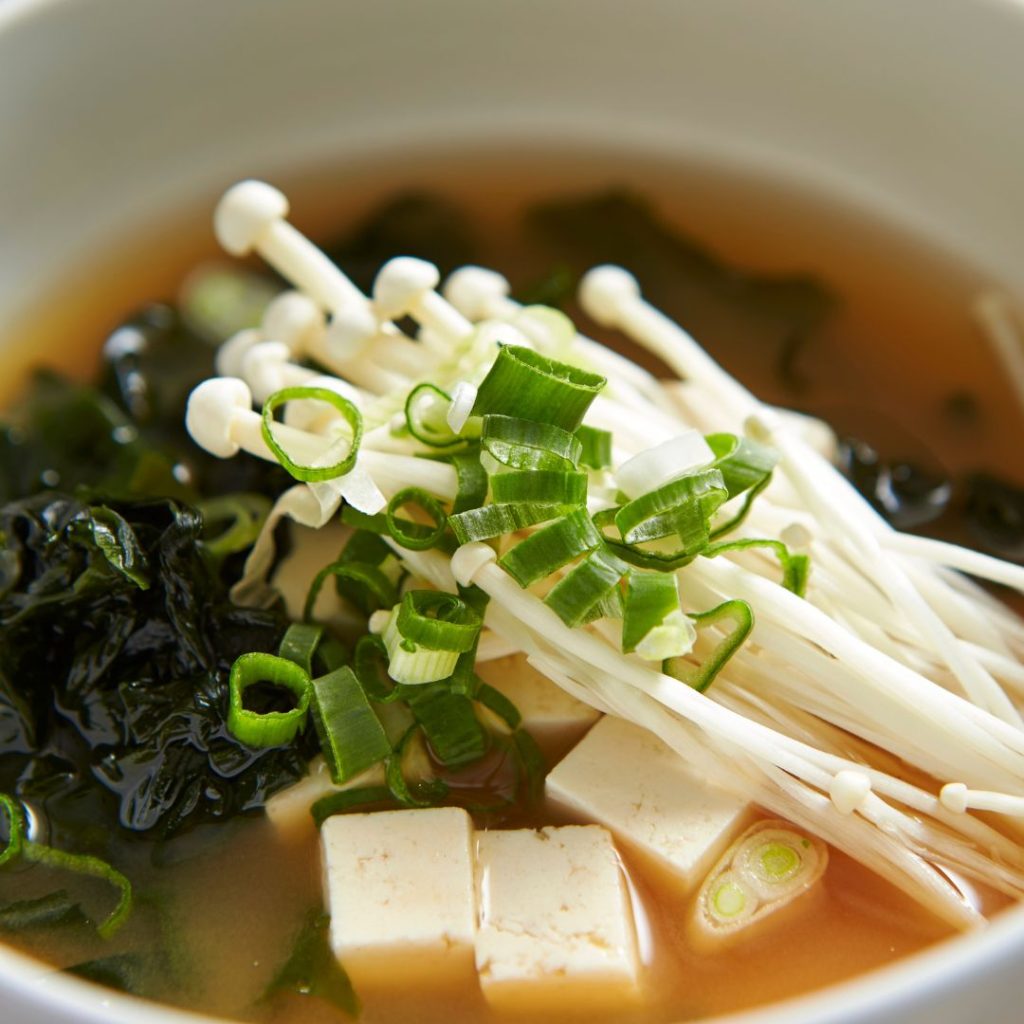Are you craving a warm and comforting bowl of miso soup, but find yourself without any miso paste? Don’t worry, I’ve got you covered!
In this article, I will guide you through the process of making miso soup without miso paste.
You’ll learn about alternative ingredients that can provide that delicious umami flavor, how to create a homemade fermentation base, and even discover some creative twists on this classic Japanese dish.
Get ready to impress your taste buds with our expert tips and tricks!

Key Takeaways
- Umami flavor in miso soup is important for adding depth and complexity.
- Alternative ingredients like chickpea miso, barley miso, and lentil miso can provide different flavors.
- Homemade fermentation using soybeans and grains or legumes can create a miso-like base.
- Enhancing the flavor with savory seasonings, herbs, and fresh vegetables can create a harmonious balance.
The Importance of Umami Flavor in Miso Soup
You can’t underestimate the importance of umami flavor in your miso soup.
Umami, often described as the fifth taste, is a savory and rich flavor that adds depth and complexity to dishes.
In miso soup, umami is essential for creating that satisfying and comforting taste.
When exploring umami substitutes for miso paste, it’s crucial to understand the role of fermentation.



Konnichiwa! (Hello!) I'm Pat Tokuyama, a Japanese tofu cookbook author, who travels for music, food, and adventure. If you like Japanese tea, checkout some of the newestorganic japanese tea, matcha bowls and noren and more!
** Curious about the Plant Based Japanese Cooking Club? ** Learn more here!
Fermentation in Miso
Fermentation is a process that enhances the umami flavors by breaking down proteins into amino acids, which contribute to the unique taste of miso.
This process also develops complex flavors and aromas that cannot be replicated easily.
While there are alternative options like soy sauce or fish sauce available, they may not provide the same level of umami as traditional miso paste does.
So next time you’re making miso soup without miso paste, consider experimenting with different ingredients and techniques to achieve that perfect balance of umami flavor.
Exploring Alternative Ingredients for Miso Flavor
If you’re looking for a substitute, there are alternative ingredients that can provide a similar flavor to miso in your soup.
While miso paste is traditionally made from fermented soybeans, experimenting with different fermentation methods can yield interesting results.
Here are some alternative miso substitutes to consider:
- Chickpea Miso: Made from fermented chickpeas, this substitute offers a mild and slightly nutty flavor.
- Barley Miso: Fermented barley gives this substitute a rich and earthy taste with a hint of sweetness.
- Lentil Miso: Using fermented lentils produces a mellow and savory flavor profile.

Homemade Fermentation: Creating a Miso-like Base
To create a base similar to miso, try fermenting soybeans with different grains and legumes for added complexity in flavor.
Homemade miso is a delightful way to elevate your dishes and add depth to your meals.
The fermentation process is key in developing the distinct umami taste that miso is known for.
Start by soaking soybeans overnight, then cook them until tender. Mix the cooked soybeans with the desired grains or legumes, such as rice or barley, and allow the mixture to ferment for several months.
This slow fermentation process breaks down the proteins in the beans and grains, creating a rich and flavorful paste.
The longer you let it ferment, the more intense and complex the flavors will become.
Experiment with different combinations to find your favorite homemade miso blend!

Enhancing Flavor With Savory Seasonings and Herbs
For a burst of savory flavor, try adding a blend of aromatic herbs and spices to your dishes.
Infusing miso soup with fresh vegetables not only adds vibrant colors but also enhances the overall taste profile.
The combination of umami-rich miso and the earthy sweetness of vegetables creates a harmonious balance that will satisfy your palate.
Adding a touch of citrus to enhance miso soup flavors takes it to another level.
The tanginess from lemon or lime zest brightens up the dish, adding a refreshing twist to the traditional flavors.
Imagine savoring a bowl of miso soup with tender mushrooms, crunchy bok choy, and hints of zesty citrus dancing on your taste buds—a truly delightful experience that will leave you craving for more.

Creative Twists: Non-Traditional Variations of Miso Soup
Adding unique ingredients like coconut milk or curry paste to your miso soup can create non-traditional variations that are full of bold and unexpected flavors.
These fusion recipes take inspiration from miso’s umami-rich base and build upon it with additional ingredients to create a truly unique taste experience.
By incorporating different broths and seasonings, you can transform a simple bowl of miso soup into a culinary adventure.
One way to experiment with non-traditional miso soups is by using alternative broths such as mushroom broth or dashi broth infused with kombu or bonito flakes.
These broths add depth and complexity to the dish, taking it beyond the traditional miso flavor profile.
Another option is to incorporate unique ingredients like tofu dumplings, seaweed noodles, or even fermented vegetables for added texture and flavor.
The table below showcases some creative ideas for non-traditional miso-inspired broths:
| Fusion Recipe | Ingredients |
|---|---|
| Thai Curry Miso Soup | Coconut milk, red curry paste |
| Korean Kimchi Miso Soup | Kimchi, gochujang (Korean chili paste) |
| Mexican Chipotle Miso Soup | Chipotle peppers in adobo sauce |
| Italian Pesto Miso Soup | Basil pesto |
| Indian Masala Miso Soup | Garam masala spice blend |
These combinations allow you to explore different cultural influences while still enjoying the comforting warmth of a bowl of miso soup.
Don’t be afraid to get creative and experiment with your own unique twists on this classic dish!
Conclusion
In conclusion, you now have the knowledge to make a delicious miso soup without miso paste.
By exploring alternative ingredients and creating a homemade fermentation base, you can still achieve that umami flavor that is essential to miso soup.
Don’t forget to enhance the flavor with savory seasonings and herbs for an extra kick.
And if you’re feeling adventurous, try out some non-traditional variations to add your own creative twist.
Enjoy experimenting and creating your own unique version of this classic Japanese dish!








Konnichiwa! (Hello!) I'm Pat Tokuyama, a Japanese tofu cookbook author, who travels for music, food, and adventure. If you like Japanese tea, checkout some of the newestorganic japanese tea, matcha bowls and noren and more!
** Curious about the Plant Based Japanese Cooking Club? ** Learn more here!